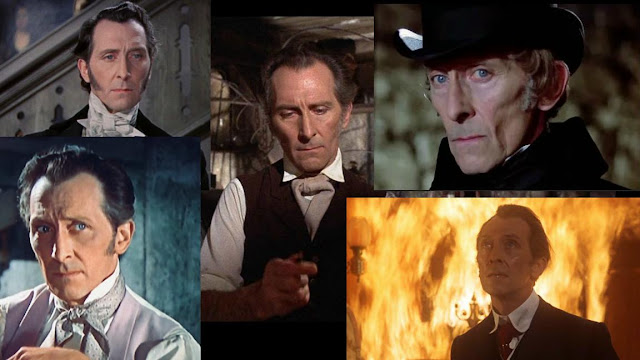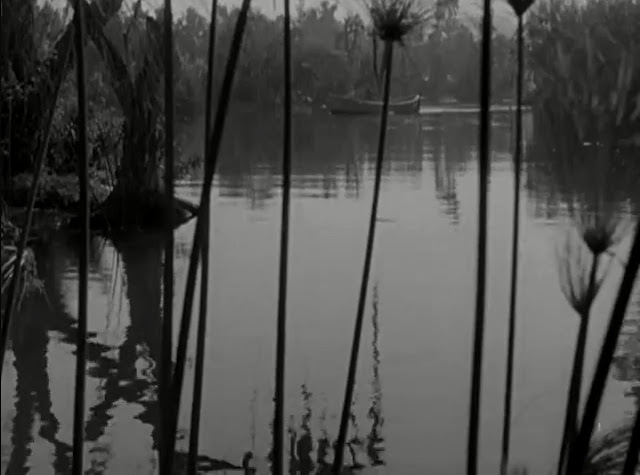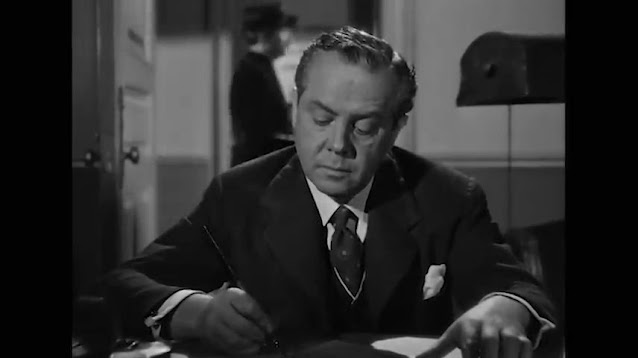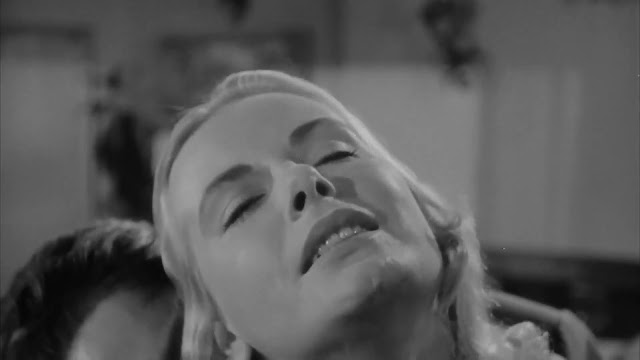Is it fair to judge a movie for what it isn't? Obviously, if it's rubbish, no one could deny it's the prerogative of those who have suffered through viewing it to rip into it like a Romero zombie horde, and that would include roasting it for all the much better things it failed to be, but what if it isn't really bad? What if it's actually a somewhat entertaining little picture but one that just spectacularly fails to live up to its potential?
October saw the U.S. television debut of just such a picture and I had just that sort of reaction to it. It's DEAD SET, a British horror "series"--in this case, essentially a movie carved into half-hour segments--about an outbreak of flesh-eating zombies that overruns the UK, and, apparently, the world.
Literally overruns it, in this case. The premise may be that of George Romero's epics, but DEAD SET eschews Romero's mournful, shuffling ghouls in favor of the hard-charging sprinters popularized in Danny Boyle's (non-zombie) 28 DAYS LATER (2002) and the godawful 2004 remake of DAWN OF THE DEAD. When it comes to the living dead, I'll confess a general partiality for the slower, stiffer breed. When trying to sell an utterly fantastic premise to an audience, it's best to try to make it as plausible as possible and it helps if what are supposed to be reanimated corpses actually look and move like one would imagine reanimated corpses would.[1] Some who share my preference are quite dogmatic about it. While my own view is that, as a rule, slower, stiffer zombies are best, if a movie works I wouldn't give that question a second thought. I'm certainly no rabid fanboy on the point.
Simon Pegg is, though. Sort of. The star of SHAUN OF THE DEAD wrote a very good mini-essay on the subject, a piece that also featured some thoughtful insights into what makes the best zombie cinema work. In particular, Simon is--forgive me--dead on in awarding the zombie "the title of Most Potent Metaphorical Monster." Zombies, as Romero used them, are such great fodder for film because they're cracked reflections of human beings. They're driven to try to eat the living, of course, but other than that, some semblance of what they were still fires through the synapses of their putrefying grey matter.[2] They're people reduced to their impulses.[3] One can use zombies to tell just about any kind of story.
The kind of story DEAD SET creator/writer Charlie Brooker and director Yann Demange were telling is about a zombie uprising that lays siege to the Big Brother house. Big Brother is a noxious--and depressingly popular--"reality" show contest wherein a diverse group of shallow fame-seekers is confined to a house for months and forced to live together, entirely isolated from the outside world and under constant surveillance. They're given various challenges and, one by one, they're eliminated, as viewers vote to "evict" them from the house.
Eviction Night is a big deal on Big Brother, and that's where DEAD SET begins, with a gala event featuring a loud crowd of rabid fans gathered to see off the evictee. That's also where it begins to fall short. Some shots of these screaming, overly-excited fans would have made a great contrast to the later shots of hordes of rabid corpses laying siege to the house. The parallel is so obvious it positively begs to be drawn. Unfortunately, DEAD SET doesn't bother to draw it, and its absence is palpable.
The series had a premise that was absolutely ripe for a relentlessly caustic satire. I'd even hazard a guess that the desire to create just that is what gave birth to the initial idea for it. By virtue of taking place around a lame-ass "reality" show, it begs for that sort of treatment. And, in fact, we do get the odd nod in this direction. One of the characters, surveying a scene of zombie carnage for the first time, blurts out, "Does this mean we're not on tele anymore?" Another, scavenging through a drug store for supplies, is excited to come across a tabloid with his picture on it then becomes upset by the less-than-flattering story in it. And the ending of the picture is sheer wicked brilliance. Unfortunately, these moments only serve to underscore the missed opportunity inherent in the decision to treat the rest of the picture like a more-or-less run-of-the-mill survival horror story. Of course, DEAD SET doesn't have to be anything other than another survival-horror movie. It had the potential to be a great deal more, though.
As a regular movie it's entertaining enough, even if it is mostly unexceptional. There's plenty of mayhem and gore. Brooker wrote some great dialogue. Most of his characters are entirely unlikable and tend to be one-note stereotypes, which is appropriate given that they're contestants on Big Brother (a fact that even led me to forgive their relentlessly stupid behavior throughout the proceedings). My favorite was easily Patrick, the unbearable Big Brother producer. Essayed by Andy Nyman, he's DEAD SET's version of Capt. Rhodes from DAY OF THE DEAD, a mouthy, dictatorial prick from his first appearance to his last.[4] His dialogue mostly consists of creative insults, and he dominates every scene in which he appears. His finest moment comes when he gets the idea of chopping up the now-dead Big Brother houseguests and using the pieces to bait the zombies away from the gate so they can escape. Everyone else is horrified by the suggestion, so he gets a knife and starts hacking on the bodies himself. He's hacking away, pulling off body-parts and getting absolutely covered in gore, and the whole time, he never stops ranting at the others, going on about how he has to work for a living, how, on the other hand, they're just fame-seeking twats who want the easy way through life and so on. The scene is way over-the-top hideous and should have been absolutely hilarious, but--yet again--DEAD SET proves not to have the stomach for that sort of humor--the moment is juxtaposed with shots of the other characters, at a distance from the carnage, crying as Patrick rants while somber music plays over it. Too bad.
So what am I to make of DEAD SET? As a survivor horror tale, it's entertaining. A bit long [5] It has its moments. It has some problems.[6] I wouldn't call it "great," and I don't see myself revisiting it often in the future. Where it really fails is in blowing what could have been some great material. The project had potential to burn. It just doesn't live up to it and the overwhelming impression with which I'm left is one of disappointment, because I can see where some better choices would have made it something very special. Is it fair to judge a movie because of what it isn't? I don't know, but with this one, I suppose I have.
--j.
---
[1] Running zombies lead to other logical problems as well. If they maintain the strength and coordination to sprint, why are doors and even flimsy fences a barrier to them? Particularly when they're in force. It's never a good sign when a movie makes one start thinking of things like this, and DEAD SET does.
[2] ...and, in that respect, eating other people doesn't seem so much the exception to their humanity as my wording, there, would suggest.
[3] ...which is why I dislike another trend in zombie flicks also followed by DEAD SET, the complete dehumanization of the zombies. They already eat people. When they also have utterly inhuman (rather than just dead) eyes, emit animal sounds, and run harder than they ever could in life, they may make ghoulish monsters but we entirely lose any connection between them and ourselves and all of the rich metaphorical material that comes with it. They may as well be invaders from Mars.
[4] His last scene, in fact, directly references Rhodes.
[5] Nearly 2 1/2 hours, a consequence of stretching a story for a feature-length film over five episodes. It isn't dull, to be sure, but the middle portion is a bit middling and the whole project is a bit padded. A subplot, for example, about the boyfriend of one of the Big Brother assistants trying to get to his girl eats up a lot of screen-time and doesn't really go anywhere--it could have been entirely excised without any real loss, except for one moment it provided which I particularly liked. The line is "I liked our farmhouse." See it in context and you'll like it too.
[6] Something I really disliked was the tiresome shaky-cam-on-steroids, which is used in all of the suspenseful scenes. The technique doesn't bother me the way it does some. It's just that it has been done to death, and rather than being an artistic choice, it's usually a substitute for one. Like the running zombies, it's blatant pandering to the zero-attention-span crowd and to be blunt, no one who is serious (or worthy of being taken seriously) should be concerned with pandering to them.
Tuesday, November 9, 2010
Friday, November 5, 2010
The Many Frankensteins of Peter Cushing
Brian, over at "The Scarecrow's Blogspot," has written an appreciation of THE CURSE OF FRANKENSTEIN, the film that, in 1957, heralded Hammer Film Productions' historic entry into Gothic horror. He doesn't say so in his blog but I believe he's even said (over on the Internet Movie Database) that this is his favorite Hammer film.
I wouldn't go that far. It's not among the best of even the larger Hammer Frankenstein series. Still, it does have its charms, the biggest by far being Peter Cushing in the lead role. Brian likes him, too:
I wouldn't go that far. It's not among the best of even the larger Hammer Frankenstein series. Still, it does have its charms, the biggest by far being Peter Cushing in the lead role. Brian likes him, too:
"The ultimate success of the Hammer series derives from Cushing's making the part all his own."Cushing is very good in the part. One hesitates for a moment about calling him the definitive screen Frankenstein only because it may be somewhat misleading, as Cushing didn't just play one Victor Frankenstein in that series--he played half a dozen.
It's fortunate that Terence Fisher directed most of those movies. Like most of the Hammer hands, he was a craftsman working in a movie factory, not some unwavering auteur with a strong, committed sense of what the series should be. While his lack of any significant cohesive personal vision for the series--and, more to the point, the mechanics of the Hammer factory--allowed for discontinuities galore,[1] it also meant we got lots of different versions of Frankenstein out of it. And since Fisher was Hammer's top director, it meant a lot of them were really good.
One--the one introduced in THE CURSE OF FRANKENSTEIN--is the relatively one-note mad scientist playing at being a god and in the end being punished for it. The next was introduced in the next film, THE REVENGE OF FRANKENSTEIN, and is almost the polar opposite, a compassionate (if, shall we say, sometimes overzealous) fellow whose work has a genuinely humanitarian aspect but who, in the end, is undone by the ignorance and bigotry of others. The succeeding films all offer, speaking broadly, either variations on one or the other or combinations of both--new versions of the character continuing his work in many different circumstances. Cushing's Frankenstein can be a malevolent chaos-agent, compassionate, slyly witty, brilliant, insane (as opposed to evil), and he's making monsters, turning himself into his own monster, transferring souls (in one installment), working for what he sees as the betterment of mankind or just following a mad personal obsession.
Which version one likes the best is probably attached to which of the films one likes best. While REVENGE isn't a great movie, I find its version of Frankenstein to be a lot more interesting. It's certainly a more complex character and he's partly likable because he really is partly likable (as opposed to being likable for being so charmingly evil). The CURSE Frankenstein doesn't have a great deal of depth and I've never cared for the idea of a scientist being punished for traipsing into the domain of God--it has an inherently anti-science bite to it I find quite distasteful.[2] On the other hand, Cushing is an absolute blast to watch when he's playing Just Plain Bad. In my favorite moment from CURSE, Paul, Frankenstein's teacher-turned-assistant-turned-critic, objects that what he's doing is inhuman. Victor retorts, "I'm not harming anybody. Just robbing a few graves." On a page, that doesn't look like much. The thing that makes it so great is Cushing's delivery--it's done offhandedly and with utter sincerity, thrown out while he continues what he was doing, as if he can't even imagine how anyone could possibly object to it. It never fails to make me laugh. The film featuring the most extreme example of an evil version of the character--FRANKENSTEIN MUST BE DESTROYED (1969)--is also widely regarded as one of the best of the series. The witty scientist contemptuous of the bigotry of his backward age found in AND FRANKENSTEIN CREATED WOMAN is great. All his work falls apart at the end and he just sort of shrugs, like he's thinking, "Well, shit, must be a day that ends in 'y'."
Fortunately, I don't have to pick a favorite. Cushing played them all and he was very good at every one of them. Even when some of the ideas embraced by the films went off into the ozone,[3] Cushing could still keep a straight face and sell them to an audience. Hammer's Frankenstein films, like all its series, are uneven in quality,[4] but even in the least of them, Cushing is always spot-on. Only once was he replaced in the role and the resulting film sucked like space, which just underlines more strongly that, to the extent those films can be said to work, he was a very large part of what made it so.
--j.
---
[1] That shouldn't be read as a slam of Fisher--continuity within all of Hammers' horror series was tenuous, at best.
[2] The theme doesn't really feature in the original Mary Shelley novel either, where Frankenstein's sin wasn't creating life but in neglecting the creature he'd given life.
[3] That soul-transplant business really just came out of the blue and went back there after that movie was over but it made for a really good movie.
[4] Though not, it should be said, as uneven as most of most of the others.
Wednesday, November 3, 2010
The Legend of Wagon Wheel Joe (Version 2.0)
When filming the cheapy Westerns he made early in his career, director Joseph H. Lewis used to tote around a box of wagon wheels. Whenever a scene was uninteresting, he'd plop down a wheel in the foreground and shoot through its spokes. The nickname this earned him, "Wagon Wheel Joe," was meant, at the time, as a put-down. In retrospect, it's emblematic of why Joseph H. Lewis should be a lot more widely respected than he is.
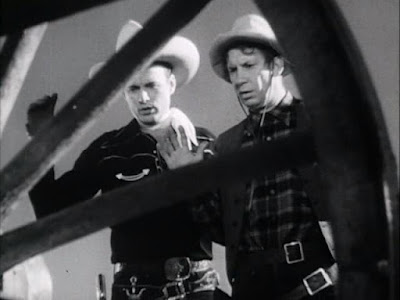 |
| Lewis' wagon-wheels in action, from BORDER WOLVES (1938) |
Lewis was one of the great B-picture artists of Golden Age Hollywood. Working mostly on Poverty Row, he didn't let perfunctory stories, trite scripts, bad actors or budgets that more closely resembled the catering bill for A-pictures slow him down. Film is primarily a visual medium and if the other raw materials with which Lewis had to work were sometimes wanting, he could at least make the movies visually interesting. Those wagon wheels were just the beginning. Lewis rebelled against the traditional "invisible" Hollywood style, shooting, instead, tight, expressionistic cinema filled with unusual and inventive camera work--odd angles, odd staging, utterly individualistic. It's said to have driven his editors nuts but it often pepped up what would have otherwise been some forgettable--sometimes even awful--films, and made some better ones better yet.
Lewis cut his teeth on those cowboy quickies. He wasn't stuck with the shortest of short ends for long though. While he remained firmly ensconced in B-level productions for most of his career,[1] his budgets, his actors and his scripts did improve and soon, he wasn't just the only good thing about a bad movie.[2] With more resources with which to exercise his resourcefulness, he came into his own as a filmmaker and proceeded to make some damn good ones.
He usually tried to hook viewers early and was frequently very good at drawing in an audience with his first scene.[3] GUN CRAZY (1950) begins on an adolescent demonstrating an almost-sorta-has-to-be sexual attachment to a pistol in a store window. So overcome is he that he just can't resist breaking the glass and stealing it, only to immediately trip over his own feet and send the gun skittering across the rain-soaked street to come to a halt at the feet of a bystander revealed, as the camera moves up, to be a grim-faced policeman, who saw the whole thing. The pre-title sequence of TERROR IN A TEXAS TOWN (1958) is one of my favorites. There's Sterling Hayden playing a beefy Swedish whaler. He's marching through a Western town, totally out of place, with a crowd gathering behind him as he comes to a particular building and calls out some badman. The villain--in black, so we know he's a no-goodnik--has a gun on his hip but Hayden is hefting a harpoon on his shoulder as his weapon of choice. They're about to have it out and we cut from the scene to the opening credits.
 |
| Sterling Hayden--so tough he brings a harpoon to a gunfight. |
There's no way in hell anyone is going to watch that and not stick around for the rest of the movie. More subtle but also effective is the opening of MY NAME IS JULIA ROSS (1945), wherein we follow the lead character through the street in pouring rain, up to a rooming house then inside, where our heroine's situation is set up via a conversation with the housekeeper. Lewis doesn't let us go until we're into the picture.
Lewis had an affinity for close-ups and favored elaborate staging and long takes. Not static ones though. His camera is always on the move, always gliding from one set-up to another without cutting. He would sometimes even allow it to pass through apparently solid objects like windows. He set-ups are often expressionistic. In CRY OF THE HUNTED (1953), a lawman (Barry Sullivan) stuck in a swamp is trying to call to those searching for him but finds he has no voice--his POV is shot through a bank of reeds that look like prison bars set between himself and his would-be rescuers.
In SO DARK THE NIGHT (1946), a--what other kind could it be?--dark thought crosses the mind of a character sitting at a desk in a fully lit room; the lights abruptly dim, leaving only the characters' face illuminated from below in an extraordinarily sinister way. The thought quickly passes and the light in the room returns to normal--all of this one unbroken take.
Later in the same film, a heated fight is photographed through the flames of a fire.
Lewis had range. He shot a wide variety of films--melodramas, a war picture, spy pictures, period adventure, horror, musicals. For his last feature, he returned to the Western and gave us the aforementioned TERROR IN A TEXAS TOWN. Much more than just a run-of-the-mill oater, the film was an open challenge to the McCarthyism of the era, ghost-written by Dalton Trumbo and Lewis' friend Nedrick Young when both were still blacklisted. Making it was a bold move, and Lewis not only shot it but also cast Young as the villain. Shot with his usual flair, it's almost like an homage to his own earliest films.
Lewis's best work, however, was in film noir and his noir-adjacent projects. ...JULIA ROSS and SO DARK... were solid, visually impressive efforts, while THE BIG COMBO (1955) was a genuine genre classic. It was also a bit notorious for one scene in which Richard Conte goes down on Jean Wallace. Conte is standing behind Wallace nuzzling her, telling he he'll give her anything she wants and drops down out of frame, as Lewis moves the camera into her face, which certainly gives away the game as the director holds the shot for a moment.
The scene initially got Lewis in hot water with the studio censors but, as he told it,[4] he turned the tables on them. Faced with their insistence that he'd shot a "filthy" scene, he professed not to understand what they were talking about. The intimation of oralism was utterly blatant but it didn't show anything. Apparently, the suggestion that they, themselves, had willfully chosen to interpret as "filthy" a scene the director (disingenuously) insisted was innocuous sufficiently embarrassed the Breen boys that they allowed it to remain in the film.
The flick for which Lewis is best remembered today though--the only one for which he's widely remembered--is GUN CRAZY. A directionless gun fetishist hooks up with a sexy, sharp-shooting sociopath, sparks of passion become a twisted obsession and soon the two are hard-charging down a path of self-delusion, robbery and murder that can only lead to their destruction, the whole of their rise and downward spiral sensationally photographed by Lewis's off-kilter camera. Easily Lewis's best picture and one of the best films noir of all time. Paul Schrader assesses that it's "one of the best American films ever made," or at least they quote him as saying so over on the Turner Classic Movies site. I certainly wouldn't characterize the assessment as hyperbole. The number of productions that have clipped from it would form a fairly sizable genre unto themselves.
Lewis has developed a cult following but that's as good as he's managed. Film nerds (like Shrader) dig him but he's a fairly obscure figure. Too obscure. His work deserves better than that, so this is my little contribution to getting it its due.
--j.
---
[1] The one exception I've seen is DESPERATE SEARCH (1952), which apparently had a much bigger budget than Lewis's other projects and also seemed to be an effort at a more "mainstream" film. Though not without its moments, the movie is, for the most part, depressingly average. Lewis ditches most of the visual flair of his other pictures and the result is the least interesting Lewis movie I've yet encountered.
[2] Since that sounds uncomfortably like an over-generalized knock on those "cowboy quickies," I'll go ahead and note that I'm a fan of both Lewis' early Westerns and the milieu in general and would certainly defend them against any accusation that they were merely disposable junk.
[3] In THE TYPEWRITER, THE RIFLE, AND THE MOVIE CAMERA, Jim Jarmusch recounting Sam Fuller's advice to him on screenwriting: "When you start your script, if the first page doesn't give you a hard-on, throw the goddamn thing away." Lewis seems to have had the same attitude. Lewis's brashness, his disregard for the conventional and the hook-'em-and-keep-'em tabloid aesthetic his films often radiate remind me of Fuller.
[4] On PBS's American Cinema series.
Subscribe to:
Comments (Atom)
